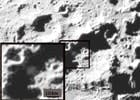The argument that the moon is a dry, desolate place no longer holds water, according to NASA.
Secrets the moon has been holding, for perhaps billions of years, are now being revealed to the delight of scientists and space enthusiasts alike.
Preliminary data from the Lunar Crater Observation and Sensing Satellite, or LCROSS, indicates that the mission successfully uncovered water during the Oct. 9, 2009, impacts into the permanently shadowed region of Cabeus cater near the moon’s south pole.
The impact created by the LCROSS Centaur upper stage rocket created a two-part plume of material from the bottom of the crater. The first part was a high angle plume of vapor and fine dust and the second a lower angle ejecta curtain of heavier material. This material has not seen sunlight in billions of years.
"We're unlocking the mysteries of our nearest neighbor and by extension the solar system,” said Michael Wargo, chief lunar scientist at NASA Headquarters in Washington. “It turns out the moon harbors many secrets, and LCROSS has added a new layer to our understanding."
Scientists have long speculated about the source of vast quantities of hydrogen that have been observed at the lunar poles. The LCROSS findings are shedding new light on the question of water, which could be more widespread and in greater quantity than previously suspected.
Permanently shadowed regions could hold a key to the history and evolution of the solar system, much as an ice core sample taken on Earth reveals ancient data. In addition, water and other compounds represent potential resources that could sustain future lunar exploration.
Since the impacts, the LCROSS science team has been working almost nonstop analyzing the huge amount of data the spacecraft collected. The team concentrated on data from the satellite's spectrometers, which provide the most definitive information about the presence of water. A spectrometer examines light emitted or absorbed by materials that helps identify their composition.
Source: NASA


